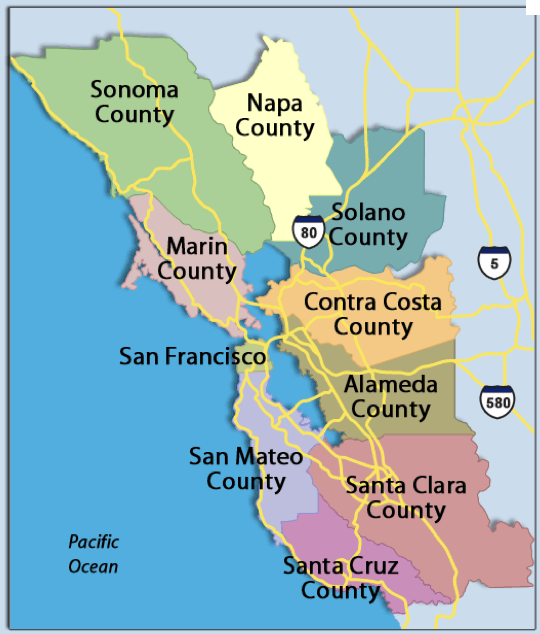As a Palo Altan, you have probably experienced the impact of new housing and growth, from parking stress to traffic during peak travel times. But the reasons behind this growth are complex and often confusing. Terms like ‘ABAG,’ and ‘housing element’ are often tossed around during debates about growth, but few people understand what they mean or why they matter for Palo Alto.
As Palo Alto debates how to handle the new demands for housing and development, Palo Alto Pulse cuts through the jargon so you can understand the regional factors that may development projects in our city.
Why does Palo Alto have to respond to regional growth demands?
California state law requires each city and county plan for its ‘fair share’ of the region’s housing needs to ensure that development is spread equitably and in relation to job growth. The definition of ‘fair share’ is determined by a different agency in each region throughout California. In the San Francisco Bay area, ABAG is the entity that determines each city’s fair share of housing.
What is ABAG?
ABAG, or The Association of Bay Area Governments, is a regional planning agency that was created in 1961 to help coordinate governmental efforts across the Bay Area regarding land use, housing, environmental quality, and economic development. All nine counties and 101 cities within the Bay Area, including Palo Alto are voluntary members of ABAG, along with local  transportation and housing agencies.
transportation and housing agencies.
How does ABAG figure out the ‘fair share’ of housing that Palo Alto must create?
t’s a complex process that begins when the State of California prepares projections for expected population growth. The State then calculates how much of this growth will take place in each region based on the expected number of households and the age and type of housing stock available. Next, each regional planning organization (in Palo Alto’s case, ABAG) figures out where this growth will take place, and allocates housing targets to each city to match the projections. The amount of housing each city must plan for is called the Regional Housing Needs Allocations (RHNA).
This regional distribution of growth is designed to do three things: 1) increase housing supply, affordability and diversity; 2) encourage efficient development to avoid sprawl and minimize greenhouse gas emissions by reducing commute distances; and 3) promote balance between job creation and housing availability.
Why does ABAG have authority over housing development in Palo Alto?
As an advisory organization, ABAG has no direct authority over Palo Alto. However, there are significant state funds and legal repercussions tied to compliance with the State’s housing requirement allocated by ABAG.
It’s hard to calculate exactly how much money is tied to ABAG compliance but estimates range from as low as $2 million to as high as $10 million a year. The potential lawsuits that could be opened up by noncompliance could be even more expensive. See more about negative impacts of not complying with ABAG below.
What’s Palo Alto’s regional housing requirement?
According to ABAG’s calculations, Palo Alto’s RHNA is 1,988. This means the City must plan to create 1,988 units of housing during the eight years between 2014-2022. The first step in complying with this requirement is to create a Comprehensive Plan including a “Housing Element” that has specific plans for reaching this target. The Comprehensive Plan and Housing Element are due January 31, 2015.
Here’s how Palo Alto’s housing requirement breaks down by type:
Very low income units: 691
Low income units: 432
Moderate income units: 278
Above moderate units: 587
That seems really high! Where is all this development going to go?
Many people have questioned Palo Alto’s RHNA and some efforts have been made to ask ABAG to recalculate it, or to appeal to the state to adjust it.
But there are a few key points to consider about this housing requirement:
- All Palo Alto has to do right now is plan: Put another way, the City is only required to demonstrate capacity for these 1,988 units by having an adequate amount of land zoned for particular housing types. So long as Palo Alto provides sufficient sites and does not impose constraints to development (i.e., by imposing unduly burdensome regulations), the city is not penalized for falling short. The RHNA represents a planning target, not a building quota.
- Palo Alto is going to grow and it’s better to prepare for it: We are lucky to have robust job growth and this is going to bring more people into the region and thus more demand for housing. This is a good problem to solve in many ways (certainly better than the opposite). So planning in response to ABAG’s requirement is part of the process the City must go through to figure out how and where to build new housing in the next eight years.
- If we do not plan for new housing, the need does not go away: By failing to plan for additional housing capacity in a thoughtful way, we risk having haphazard development that could create a future Palo Alto that is very different from the town we love.
Couldn’t Palo Alto just ignore ABAG or drop out?
Unfortunately, California law requires that all jurisdictions in the State must have an adopted and approved Housing Element as part of their General Plans. Palo Alto is legally required to create a Housing Element that meets ABAG’s RHNA targets and is approved by the Department of Housing and Community Development by January 31, 2015.
Even if Palo Alto decided to drop out of ABAG, we would still receive regional housing requirements, only from the California Department of Housing and Community Development rather than from ABAG (see Corte Madera’s story).
There is little evidence that a city has ever successfully argued against having to comply with Housing Element law.
Why don’t towns like Atherton and Portola Valley have these big housing requirements from ABAG?
Simply put, these towns don’t produce many (or any) jobs. We might have mixed feelings about all the new companies in Palo Alto, but their presence creates foot traffic that allows for new restaurants and retail, which help increase revenues for Palo Alto.* Have you ever been to downtown Atherton? Enough said.
* Yes, many of these ‘ground floor’ establishments have disappeared in recent years, but downtown Palo Alto is still buzzing with activity. Palo Alto Pulse will cover these tradeoffs in a future post.
What are the consequences of not complying?
 Not only is Palo Alto legally required to comply with its RHNA, there are some serious negative repercussions of failing to have a housing element plan approved by January 31, 2015:
Not only is Palo Alto legally required to comply with its RHNA, there are some serious negative repercussions of failing to have a housing element plan approved by January 31, 2015:
- Lawsuits and lots of them: Developers and advocates have the right to sue Palo Alto if we do not have an adopted and approved Housing Element. Recent Bay Area cities that were successfully sued include Menlo Park, Corte Madera, Alameda, Berkeley, Napa County, and Santa Rosa.
- Loss of State funding: Big State agencies, including the California Infrastructure and Economic Development Bank (CIEDB) and the Bay Area’s Metropolitan Transportation Commission (MTC) award funds based on competitions that require an approved Housing Element. Palo Alto could not apply for these funds without an approved plan.
- Even bigger housing requirements in the future: Without an approved plan, Palo Alto would be required to carryover any unfilled RHNA units into future planning efforts. This means that the City’s next RHNA target would include not only for any new growth targets from ABAG but also for the unfulfilled RHNA from the prior planning period.
What happens if Palo Alto gets sued?
Mandatory compliance – The court may order Palo Alto to bring our housing plan into compliance according to external guidelines and requirements.
Loss of local control on building decisions – The court could suspend Palo Alto’s ability to approve of building permits, zoning changes, or variances.
Expensive legal fees – If Palo Alto is sued due to lack of compliance and either loses or settles the case, it could owe substantial fees ($100,00 or more) to the plaintiff’s attorneys and its own attorneys.
So what are Palo Altans supposed to do with all this information?
Information is power and understanding ABAG, RHNA and the Housing Element will help you make good choices as a voter and citizen. In addition, there are three things you can do now to help move this conversation forward:
- Vote on November 4th: The candidates running for City Council represent a range of perspectives on development and growth in Palo Alto. No matter what you believe about growth in Palo Alto, get informed about where the candidates stand on these key issues.
- Review the draft Housing Element: On September 5, 2014, the City received a letter from the Sacramento saying the most recent draft was substantially in compliance with State requirements for Housing Element certification. The City is in the final stages of gathering feedback and City Council is slated to vote on the plan in November.
- Get involved and share your perspective: Visit Our Palo Alto to learn about forums and community events designed to engage Palo Altans or weigh in online through Open City Hall to get your voice heard.
Resources and references






great piece, victoria… really valuable, and something everyone should keep bookmarked!
FYI: Lawsuits motivated Menlo Park and Pleasanton to create compliant housing elements.
Menlo Park settles housing lawsuit: City commits to updating plan, finding affordable housing sites: http://almanacnews.com/news/2012/05/17/menlo-park-settles-housing-lawsuit
Pleasanton City Council OKs new Housing Element, ending 7-year legal battle at cost of $3.9 million: http://www.pleasantonweekly.com/news/2012/10/17/city-council-oks-new-housing-element-ending-7-year-legal-battle-at-cost-of-39-million
This article is super helpful. I have long wondered why Palo Alto must comply with ABAG’s mandates for expanded housing in a city that already (IMHO) has more housing density, congestion, and traffic than is ideal. (I left San Francisco to buy a home in a smaller town…but am watching it transform into a place with very different quality of life with more congestion, over-capacity neighborhood schools, and the threat/need of neighborhood parking permits..shades of San Francisco!)
If I am reading the article correctly…getting involved at the city level, while important, will not be enough. It sounds as though state mandated housing growth leaves whoever is elected to City Council with only limited ability to maintain the kind of growth citizens might prefer. The question then becomes how do we impact the state mandated (ABAG recommended) growth goals and the state policies that hold funds hostage for communities that choose a lifestyle that does not include dense housing and crowded streets?
How can we, as citizens, help change the fact that “Palo Alto is legally required to comply with its RHNA (that requires major increases in housing density)” and that “Developers and advocates have the right to sue Palo Alto if we do not have an adopted and approved Housing Element (that significantly increases housing density)”. I’m seriously interested to know how we can impact change in these state policies/laws.
It seems kind of crazy to me that the state can mandate that a city grow its housing faster than the city wishes to grow. I see why that would benefit developers, but not how it benefits quality of life for Palo Altons. It is possible of course, that the majority of Palo Altons want to grow as fast as ABAG mandates. My views may not be the majority view. But it seems to me that Palo Altons should make that call, rather than Sacramento or ABAG.
I’m eager to hear perspectives on how we change the State mandates for housing growth…that seems to be where the problem lies.
Deb, actually the congestion you are seeing in Palo Alto is not a result of increased housing density, but a combination of one of the highest jobs-housing imbalances in the nation and one of the highest costs of housing. There is also a lack of housing options — the majority of our housing stock is single family housing, faaaar out of the price range for many young professionals and service workers, who cannot find rental units they can afford. But the jobs in PA are one of the best paying in the area, and we have a lot of them — 3.1 jobs for every working age individual living in Palo Alto. So every day our city doubles. But not because we have built a lot of housing. It doubles because we have built so little, and it is so expensive that most of our work force has to live elsewhere. We desperately need more studios and 1-2 bedroom units near transit and services, so that more of our workers can walk places and don’t have to drive in and our of our City. Expanding this type of housing stock won’t take a toll on our schools either, as most of people living in Jr-2BA do not have kids. Meanwhile, impact fees from new development can help us improve our infrastructure and invest in expanding alternative transportation systems, such as our shuttle and bus systems.
Questions I’d like answered: Are ABAG’s calculations and assumptions used in making the housing requirements available for our viewing? And, I’d like to see income $$ associated with the four types of housing required as shown in the breakdown. Would the highly paid office and tech workers who commute to Palo Alto every day squeak under the ‘moderate’ or ‘above moderate’ income levels?